SCAN the Situation with VXS

A VXS SCAN gives you the map, the means and the momentum to turn opportunity into progress.
It moves you from navigator to driver: Reveal. Align. Create buy-in. Build commitment. Deliver.
That's how genuine change begins.
The SCAN process
Survey
Ask the right questions, then generate radars and a SWOT.
Use a quick strategic intake to create results.
Connect
Create a maturity overview, reveal patterns in pain points.
Identify causes and consequences.
Analyze
Quantify the gap. Project outcomes, KPIs, and failure points.
Present a clear, scoped roadmap.
Next
Turn options into ownership, and insight into execution.
Start action with clarity.
Step 1 – Survey: Frame the Situation
Every engagement begins with uncertainty. Your client might have a hunch about what’s wrong — but no shared language, no clear scope, and no structured path forward.
And often, depending on whom you speak to, you’ll hear radically different stories about what the real problem is.
The Survey step creates neutral ground. With VXS, you move beyond generic discovery sessions or sprawling workshops. Instead, you guide a rapid, focused intake that surfaces what works, what doesn't, and where the friction lives — without triggering defensiveness.
Note: VXS is not another data-cruncher scraping flawed telemetry to deliver black-box insights disconnected from reality. VXS operates from a different premise: that what people see, feel, and experience is essential data — often the only data that reveals how the system truly operates.
This makes VXS uniquely human-centric: built to work with lived experience, not just spreadsheets. And yet it avoids the traps of personal bias or learned helplessness by making the subjective view structured, visible, and challengeable.
Here's how you SCAN a client's situation:
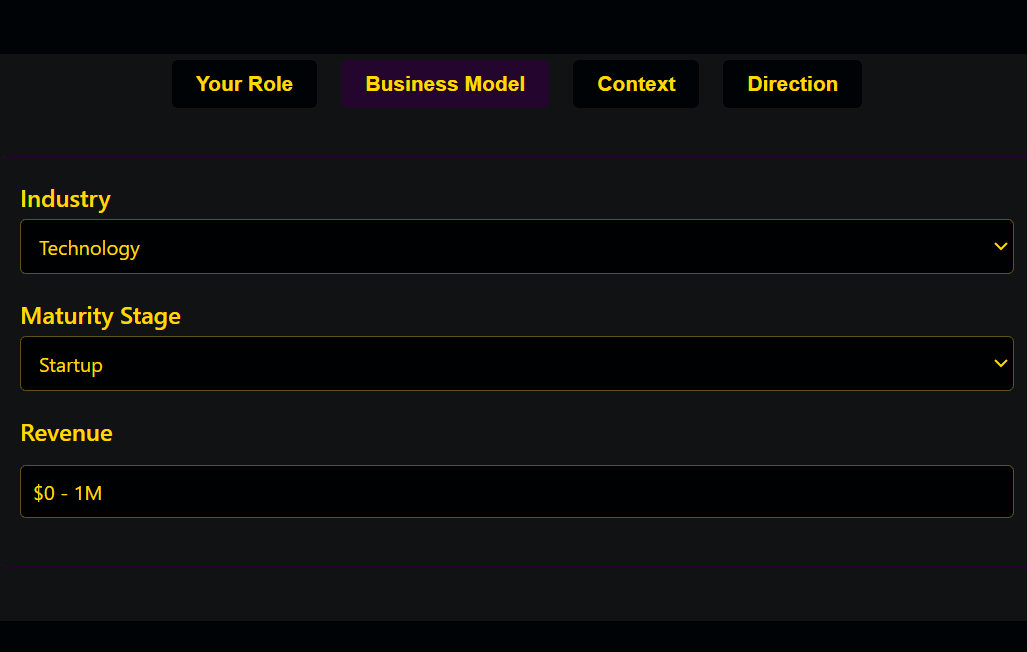
Set the Strategic Context
What you do: Quickly capture the core signals: role and focus, market and revenue, operational context and key challenges. This frames the scope and sets expectations.
What you get: A custom diagnostic space that dynamically adapts to the client's situation and needs.
Why it matters: You start the conversation with relevance. That means no wasted time — and immediate trust.
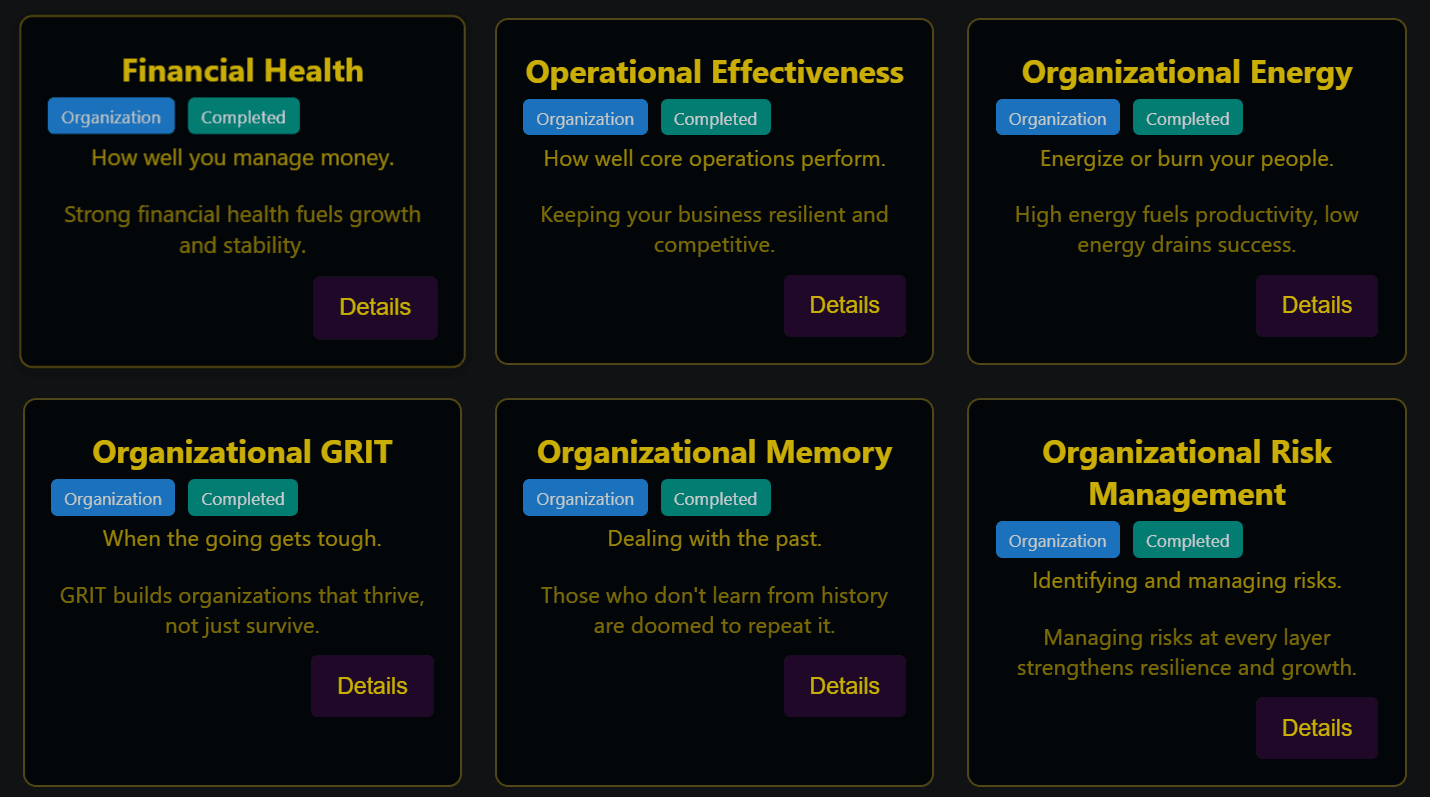
Select Target Dimensions
What you do: Choose which areas you need to assess - spanning from strategic foresight to personal mood.
What you get: A modular, highly relevant diagnostic survey suitable for your context.
Why it matters: You decide and create the focus, without process overhead. That earns attention fast.
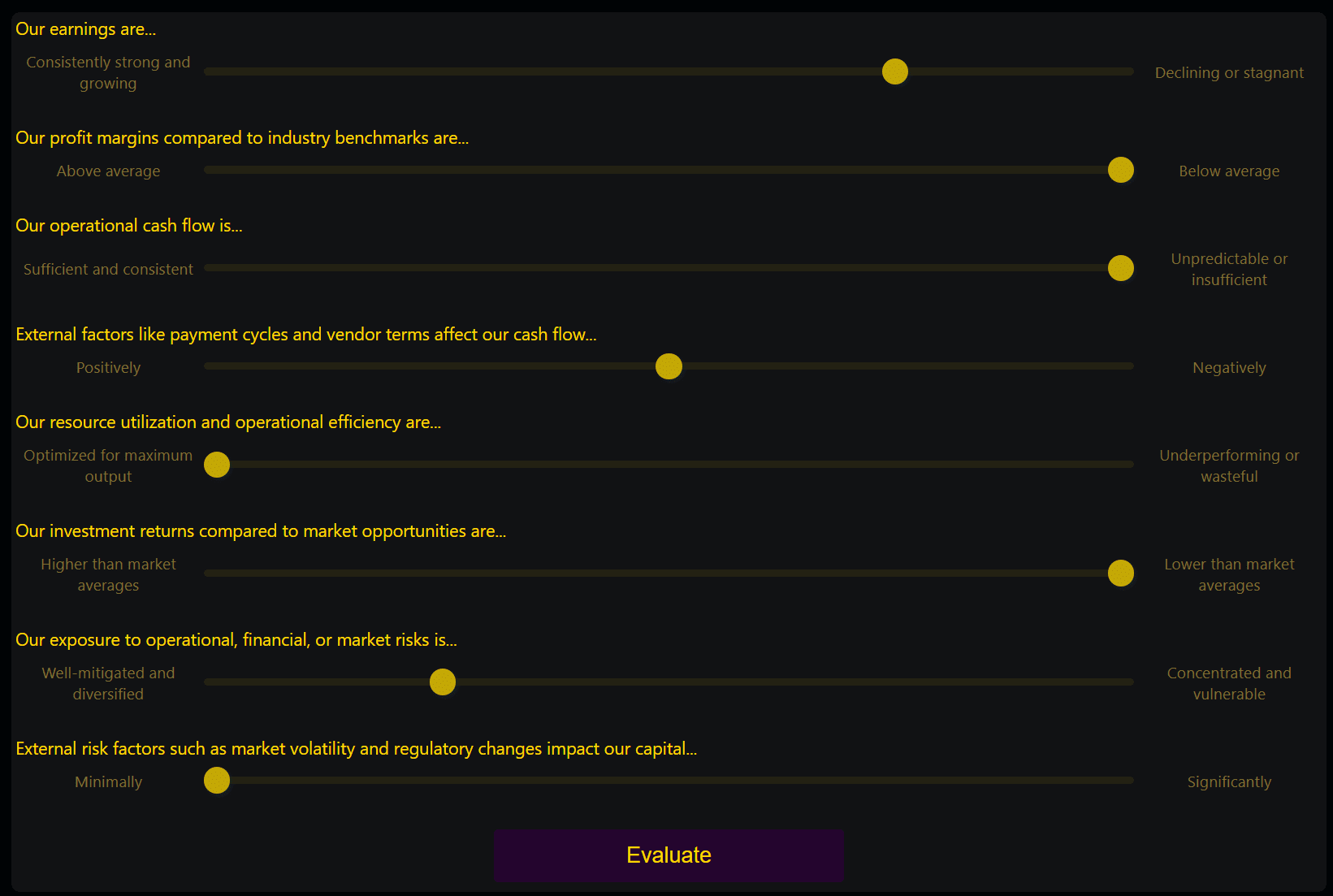
Let People Map Their Own Reality
What you do: Walk your clients through our intuitive surveys and structure the conversation. Capture how they perceive their situation in that specific area.
What you get: Structured input. What superficially looks like an inquiry of personal opinion is a systematic quest for systemic performance signals.
Why it matters: When the client participates in the diagnosis, they come to their own conclusions. Asking the right questions early is the key to buy-in.
VXS Surveys are standardized to absorb blame and nullify power games. Our highly focused, impact-maximizing questions designed with years of experience are neutral towards the specific context, and still capable of clearly pointing out areas of pain.
Therefore, we do not support custom surveys, as indiscriminate diagnostics may skew processing and outcomes. However, we offer training how to maximize the effectiveness of VXS surveys in your own consulting approach.
Step 2 – Connect: Turn Signals into Patterns
Most clients don’t suffer from a lack of information: they suffer from an overload of disconnected impressions. The Connect step is about synthesis. You take the raw, self-reported assessments and surface the systemic tensions behind them.
The power of VXS is that it doesn't stick to symptoms. You can see how issues interlock, which ones accelerate others, and where misalignment quietly bleeds value. Your focus is cutting the Gordian Knot: finding the one place where a precision cut will change the dynamics.
VXS transcends both linear cause-and-effect and causal loops - it models trajectories and destinations. That's how complex, scattered concerns turn into a clear, navigable map: "Are you going where you want to be? If not: what needs to change?"
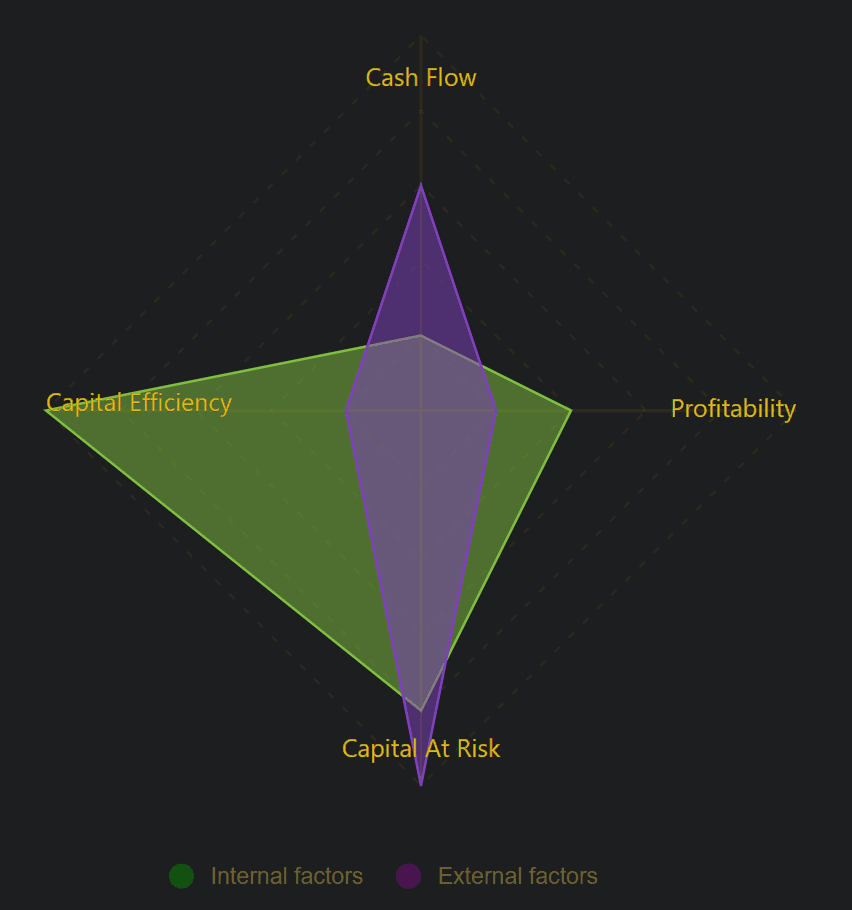
Expose Strategic Imbalance
What you do: Use the radar to show mismatches between internal capabilities and external imposition.
What you get: A fast visual readout of where pressure is building - often where everybody felt, but nobody saw it.
Why it matters: Systemic fragility becomes visible. Tangible. Manageable.

Translate Patterns into Action
What you do: Review the basic suggestions auto-generated by VXS. These are low-hanging fruit.
What you get: A curated list of common leverage points, filtered by feasibility and urgency.
Why it matters: You move the conversation from “where does it hurt?” to “here’s something we could try.”
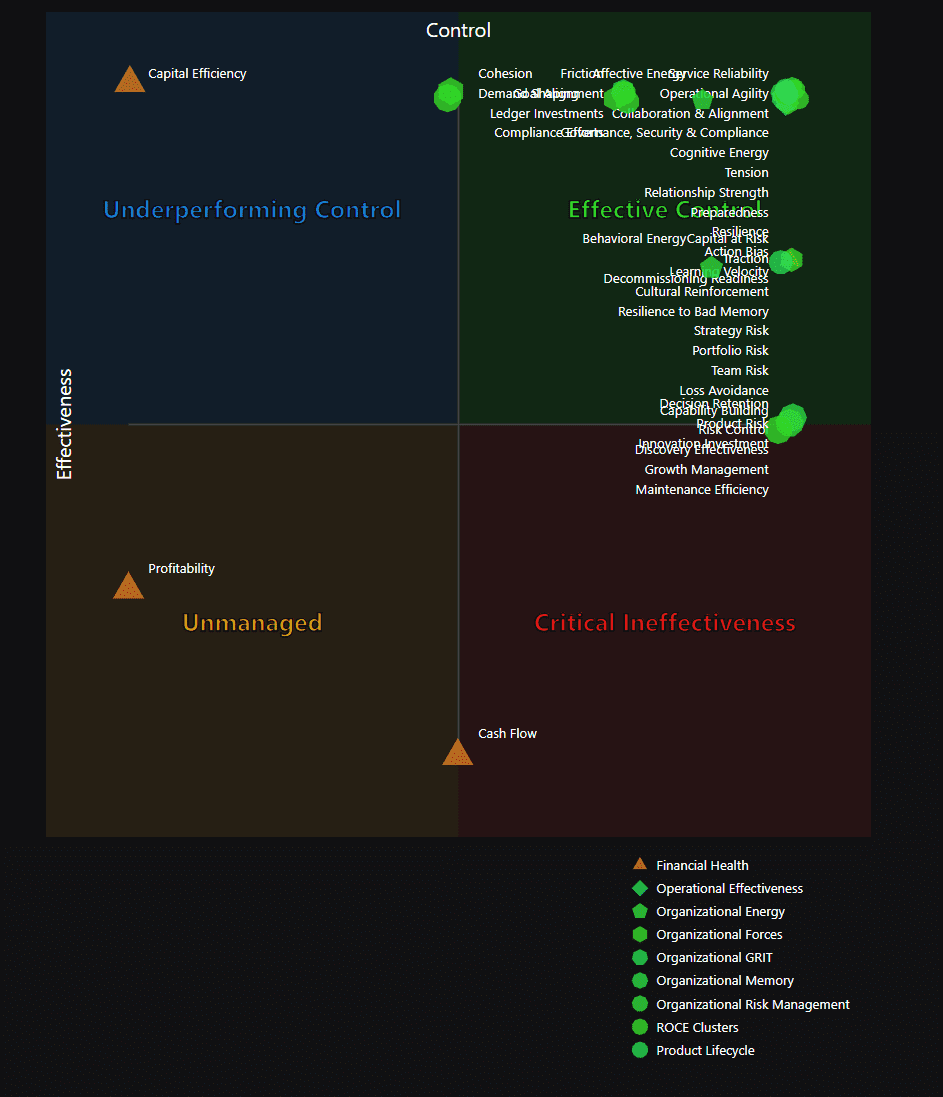
Position What’s Working - and What Isn’t
What you do: Locate each factor in the simple Capability Quadrant Model.
What you get: A clear view of what’s stable, what’s wasting potential, and what’s actively damaging.
Why it matters: The mere colors of the quadrants tell you where to focus. The simple order? Critical ineffectiveness first - it's where you're investing effort that aren't working out as intended. "Effective Control" last - optimization there is gold-plating.
A simple visual metaphor? Think of balloons - you want everything to rise to the top.
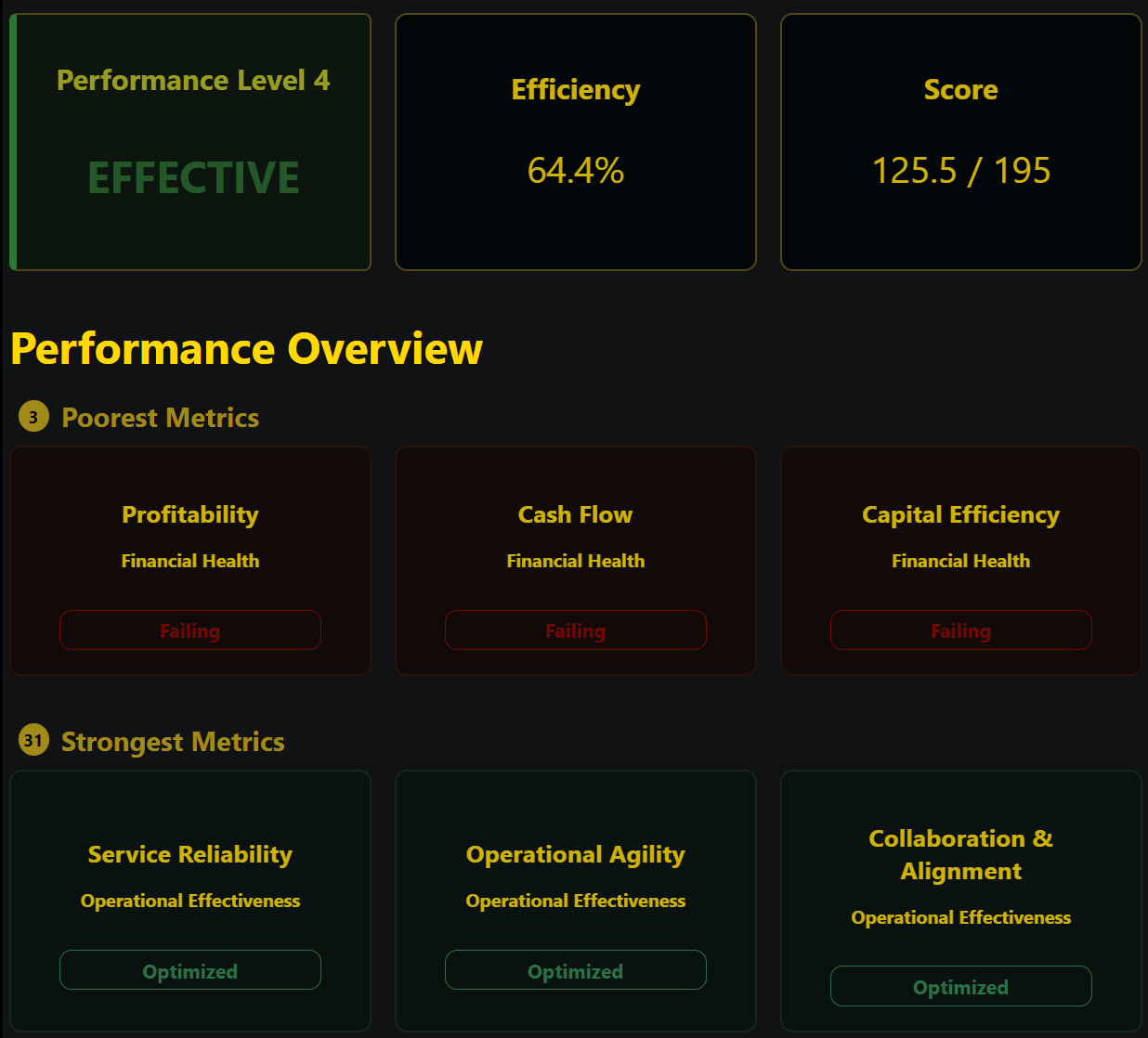
Summarize the situation
What you do: Present a synthesized maturity and effectiveness overview across all scanned domains.
What you get: A summarized snapshot that tells leadership: “Here’s how far along you are - and what that means.”
Why it matters: The narrative moves from opinion to orientation. Everyone sees the same map - and the balls that need to get rolling.
VXS creates a 5-stage Maturity model ranging from "Failing" to "Optimized." We suggest focusing on the fewest high-impact metrics in the "Poorest" section, and setting optimization targets for these. That drives impact.
VXS is well aware that factors are interconnected, so if you'd try to optimize a failing metric by cannibalizing a successful capability, VXS will let you know the consequence. You are free to propose it anyway - but you'll be warned!
Step 3 – Analyze: Define the Core Issue
With patterns revealed, it’s time to make them mean something. VXS supports you in interpreting root causes, defining primary goals, and laying the groundwork for resolution.
As a consultant, it's now time to move into the VXS "Consultation room" where our virtual, AI-powered high-profile specialist advisors will support you with their expertise to make sense of the situation. Each of them has a personality and a focus, and they will contribute to help you create clarity and results.
For example, Frank is an expert at telling you about risks.
Leila has a knack for extracting a focused goal with measurable outcomes from any conversation.
Or Callum, who will gladly turn any rough idea into a structured plan.
All of our experts are fully aware of the context, and they will use it when offering advice.
You can communicate with them in any order, or create your own structured flow to answer the questions
you want to ask.
Here's an example conversation flow you may have:
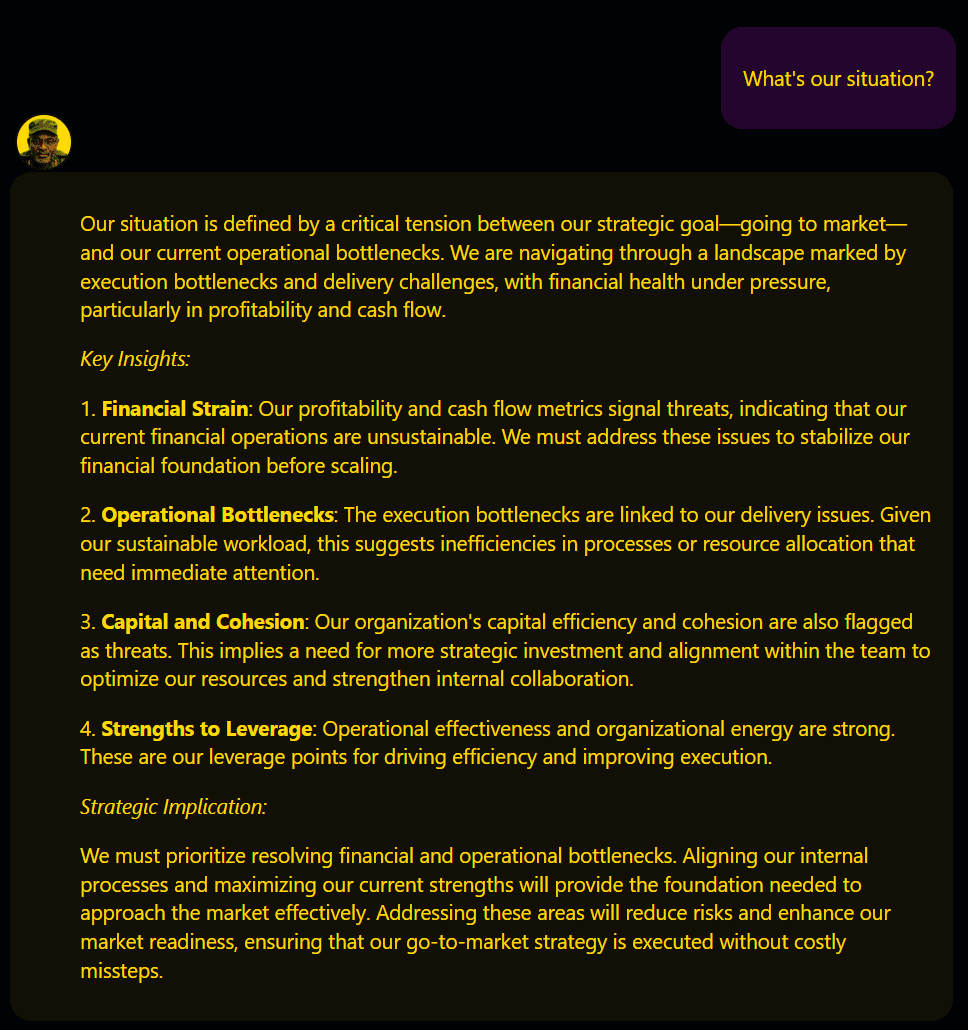
Check the Big Picture
What you do: Ask Colonel Adebayo for a strategic overview of what you're facing.
What you get: A brief summary of the weak spots, where you face the most heat, and what matters first.
Why it matters: Meaningful change requires turning incongruent, conflicting or even mutally contradicting perspectives into a consistent narrative.
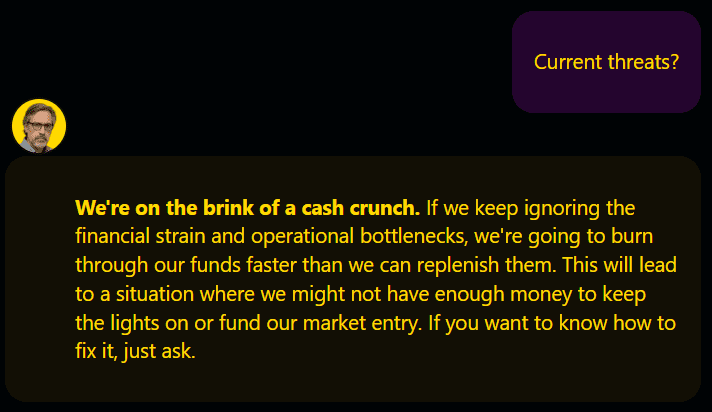
Gauge Key Risks
What you do: Check in with Frank to surface risks that are either in the system already, or that could be introduced by a move you're preparing.
What you get: A blunt analysis of downstream impact. You’ll know where you might bleed resources, lose momentum, or derail execution.
Why it matters: Good leadership is risk-aware. But most teams are blind to second-order effects. Frank makes them visible.
Frank is sparse on words, as his philosophy is "If your number 1 problem is solved, Number 2 gets a promotion." He resists the notion of tackling everything at once. To uncover further risks, you need to dig until you're satisfied.
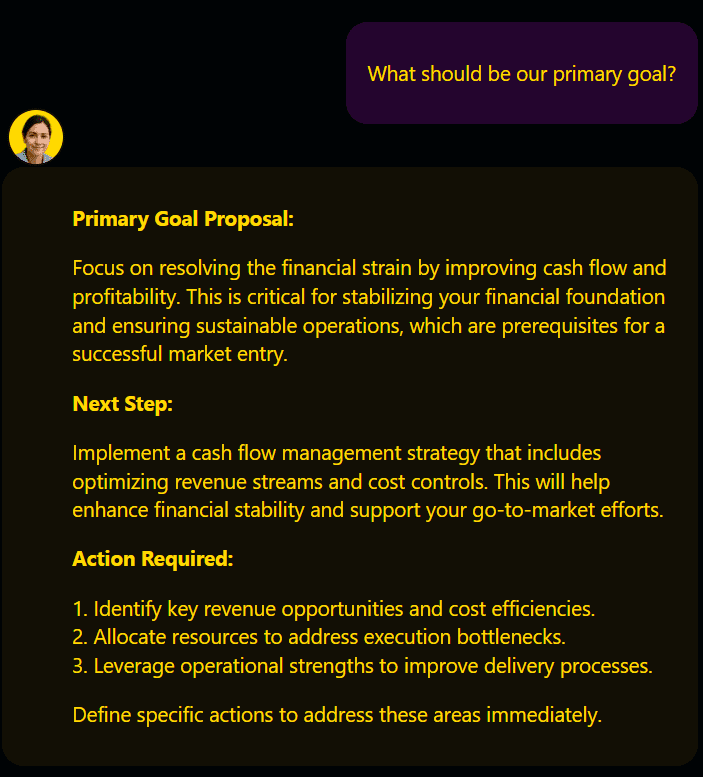
Define the Most Valuable Goal
What you do: Inquire Leila what goal is worth pursuing. Or alternatively, if you have an idea for goal, check with her whether that goal makes sense.
What you get: A clearly scoped objective that accounts for your context and constraints — not just wishful thinking.
Why it matters: Without clarity, execution stalls. With it, everything else aligns around the right problem.
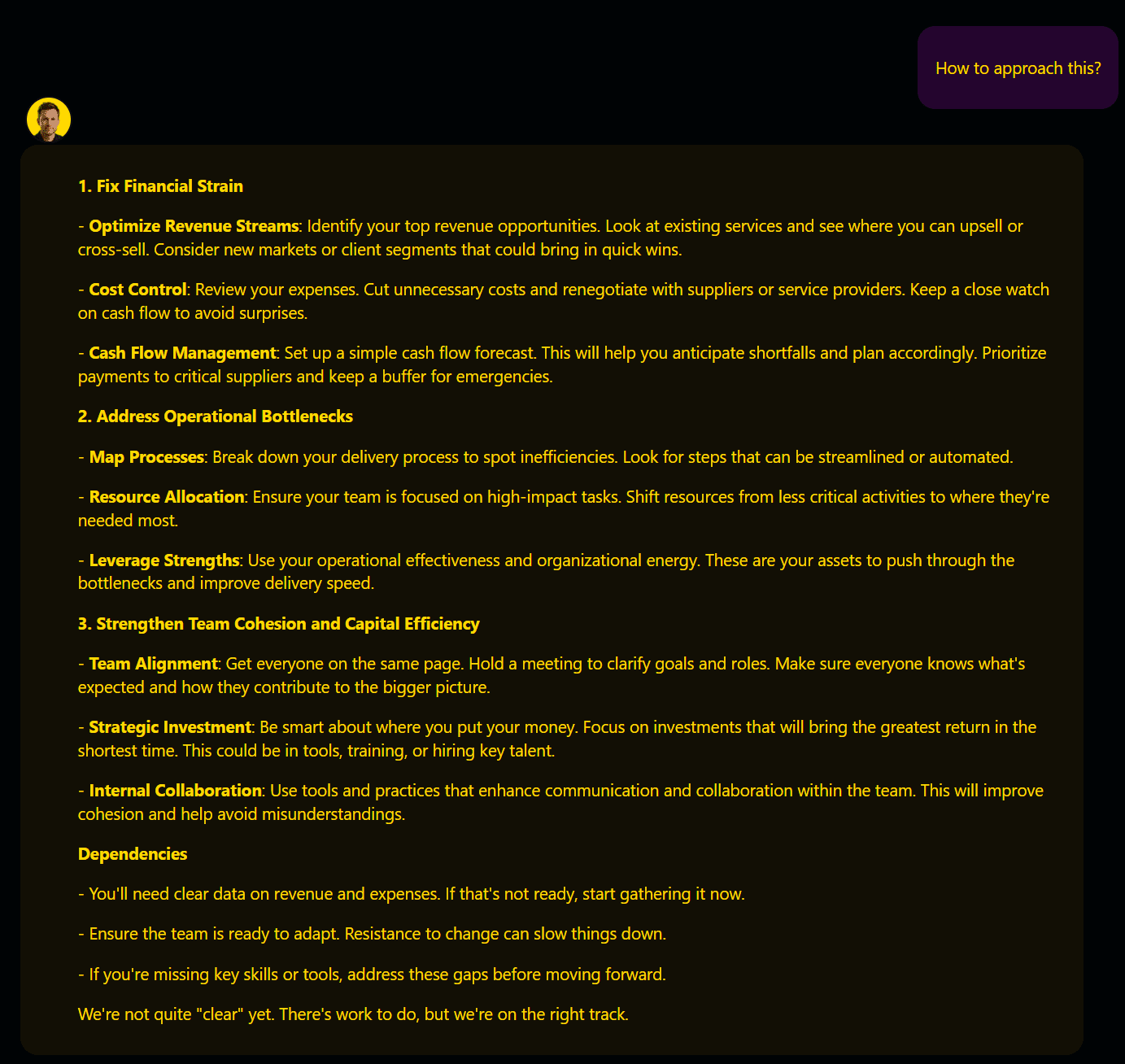
Turn Insight into Structure
What you do: Let Callum turn your direction into a plan - he'll figure out quickly what to do, in which order, and why.
What you get: A general overview of the key moves, expected outcomes and dependencies you may face.
Why it matters: When leadership sees execution logic, not just ambition, buy-in accelerates.
Just like in a real meeting, Callum will give you some quick input: If you're satisfied, take his idea to the VXS "Create a Plan" feature to elaborate a quick idea into a presentable plan.Our virtual VXS consultants are your personal advisors for turning insights into results. The information they present can be exposed to the client at your discretion - there is no need for the client to directly interact with them. They do not replace your expertise, but they augment your ability to connect dots by orders of magnitude!
VXS advisors decide based on the information available to them.
Given wrong information, and they may give advice that leads off-track.
While they have some ability to figure out whether you're taking them for a ride - "you get what you ask."
Final choice rests with human decision-makers, and our advisors will help you make the best out of your choices.
In case of doubt, it's a good idea to check with Coach Tom whether a goal or a change makes sense.
Once you lock in a choice, Coach Tom will hold you accountable for that decision - even if it was bad!
We encourage you to familiarize yourself with each persona and how they can support your journey of generating the best possible results in a complex situation.
Step 4 – Next: From Option to Ownership
Insight without action changes nothing. That’s why the final SCAN step isn’t just “handing over a plan.” You're building momentum for turning possibilities into reality. As a consultant, you're there to take companies out of an undesirable state and help them get the results they want. And in a complex world, there's no "one best way" - but multiple options with advantages and drawbacks, pitfalls and opportunities.
That's why VXS doesn't assume a single "right path." Instead, we encourage you to keep options open until a decision has been made that locks in a future trajectory.
VXS helps you quickly create multiple concrete options for execution, compare them transparently, and guide leadership to own the one that fits.
You’ll use two functions here: Plan Creation and Option Comparison. Instead of prescribing a path, you structure choices — each one grounded in the earlier analysis. This shifts the dynamic from “advisor delivers” to “client commits.”
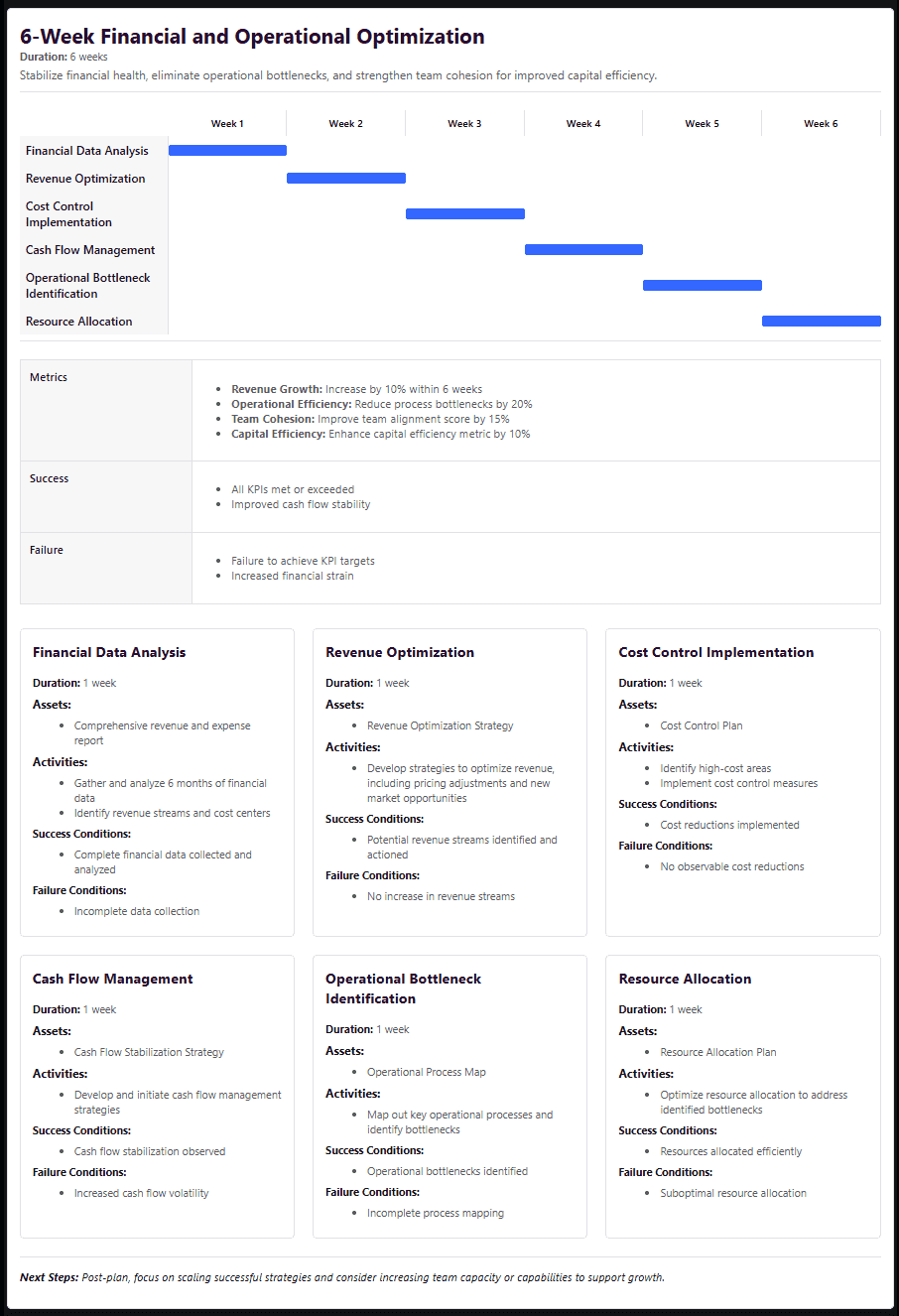
Create a Viable Execution Plan
What you do: The Plan Creation feature turns Callum's draft plans into a custom-built plan tailored to the client’s pain points, capacity, and urgency.
What you get: A structured sequence of key moves - including a high-level Gantt chart, impact on key metrics, success and failure conditions, as well as key deliverables of each phase. .
Why it matters: Execution becomes structured. You move away from justifying efforts, refocusing on creating results and navigating known risks.
The best way to proceed is not to create a single plan, but to tune the various key parameters: Desired outcomes, success metrics, duration and acceptable risks. Leave the details to VXS - it will fill in plausible details that you can later adjust.
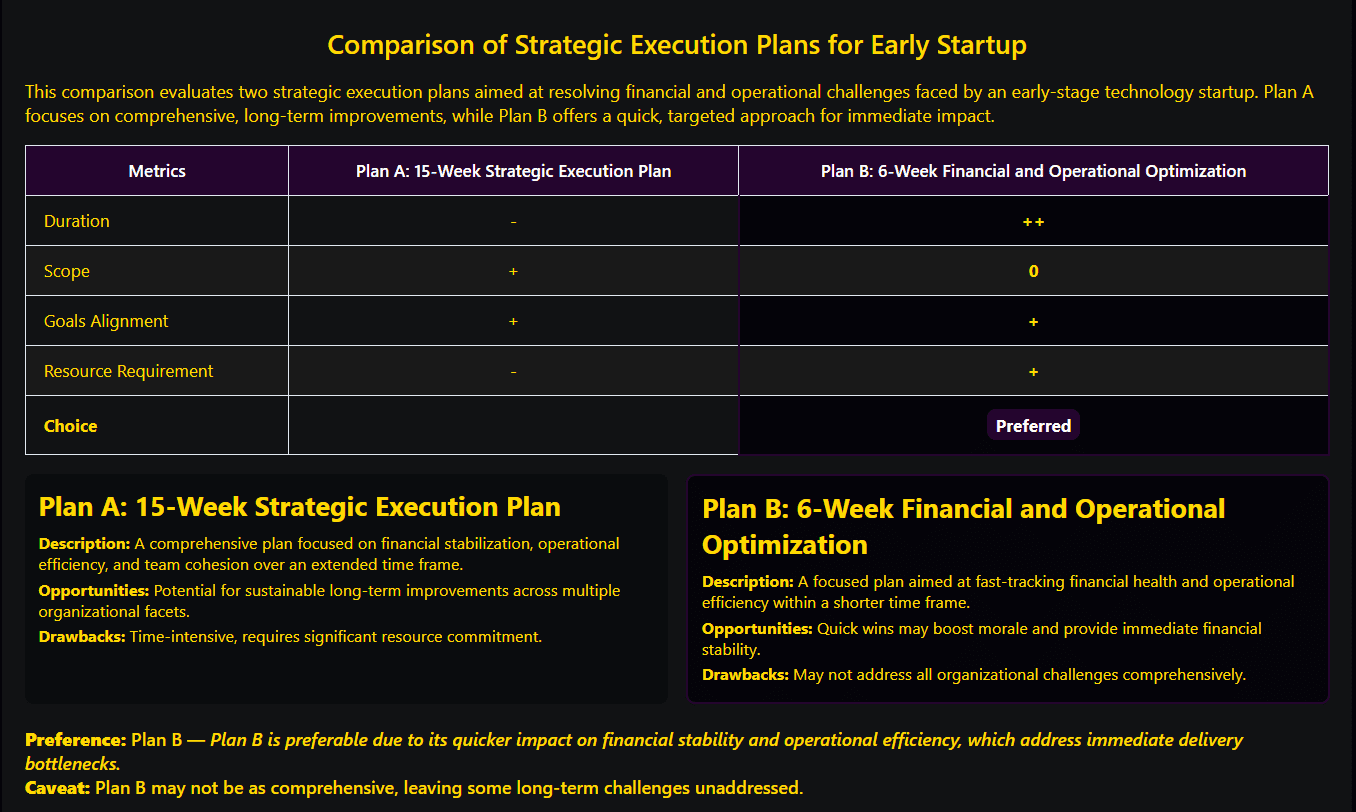
Compare Options, Then Decide
What you do: Take the best 2-3 planning options to the VXS "Option Comparison" and let it do its magic.
What you get: A side-by-side view to make tradeoffs on key metrics visible. The comparison metrics are auto-defined by the project's key success factors and the client's situation. VXS will also use the information to propose the "preferred" way forward and make the case.
Why it matters: Clients don’t just agree to a plan - they select it, and they want to know what they're choosing. That choice creates buy-in, clarity, and alignment: You’ve moved from advice to decision enablement.
The "Option Comparison" extends far beyond comparing plans - you can throw anything at it. Even a vague idea like, "I need 3 different ways to increase sales," and you get context-aware, weighted, prioritized options as well as a recommendation.
This is where the SCAN process completes: You started with scattered symptoms, and end with a team committed to action, working from a plan they understand and believe in.
From here, the path shifts to delivery - and the clarity you’ve gained through SCAN ensures execution begins with confidence and alignment.
SCAN isn’t just a clever acronym: It’s a rapid, reliable and repeatable structure for building trust. It turns you into a strategic partner before the engagement even begins.
VXS is a force multiplier, not an autopilot. It does not replace your expertise: it augments what is already there, and documents insights in a structured manner, systematizing the basics. Your ultimate success factor is: You.